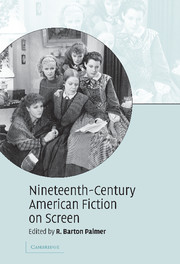Book contents
- Frontmatter
- Contents
- List of illustrations
- Notes on contributors
- Acknowledgments
- Introduction
- 1 A very American fable: the making of a Mohicans adaptation
- 2 Romancing the letter: screening a Hawthorne classic
- 3 The movies in the Rue Morgue: adapting Edgar Allan Poe for the screen
- 4 Readapting Uncle Tom's Cabin
- 5 Screening authorship: Little Women on screen 1933–1994
- 6 Melville's Moby-Dick and Hollywood
- 7 Screening male sentimental power in Ben-Hur
- 8 John Huston's The Red Badge of Courage
- 9 Translating Daisy Miller
- 10 Jane Campion's The Portrait of a Lady
- 11 The Europeans – and the Americans
- 12 Sister Carrie becomes Carrie
- 13 Hollywood and The Sea-Wolf
- 14 An untypical typicality: screening Owen Wister's The Virginian
- Filmography
- Index
14 - An untypical typicality: screening Owen Wister's The Virginian
Published online by Cambridge University Press: 22 December 2009
- Frontmatter
- Contents
- List of illustrations
- Notes on contributors
- Acknowledgments
- Introduction
- 1 A very American fable: the making of a Mohicans adaptation
- 2 Romancing the letter: screening a Hawthorne classic
- 3 The movies in the Rue Morgue: adapting Edgar Allan Poe for the screen
- 4 Readapting Uncle Tom's Cabin
- 5 Screening authorship: Little Women on screen 1933–1994
- 6 Melville's Moby-Dick and Hollywood
- 7 Screening male sentimental power in Ben-Hur
- 8 John Huston's The Red Badge of Courage
- 9 Translating Daisy Miller
- 10 Jane Campion's The Portrait of a Lady
- 11 The Europeans – and the Americans
- 12 Sister Carrie becomes Carrie
- 13 Hollywood and The Sea-Wolf
- 14 An untypical typicality: screening Owen Wister's The Virginian
- Filmography
- Index
Summary
A contradictory legacy
As a phenomenon, adaptation customarily figures in critical analysis as a series of singular transactions, that is, as instances involving one-to-one relationships between source-texts and their cinematic refashionings. Rarely, a film may adapt several sources, imposing a textual unity (at least of sorts) on a literary multiplicity, as in the case of Robert Altman's film Short Cuts, which draws on narrative motifs derived from a number of Raymond Carver short stories. And in at least one special instance, cinematic adaptation is more accurately described as the serial forging of transtextual ties rather than as a unique transformative gesture. Thus adaptation of this kind has multifarious and global effects, with influence to be traced not only in a film that shares the same identity as its source, but also in an emerging series of films that are not “identical,” so to speak, but more indirectly related. A literary text, in other words, may give rise to a cinematic genre whose unfolding proceeds for decades.
Such was – and is – the influence on American culture of Owen Wister's The Virginian (published in 1902, but in large part composed at the close of the previous century, whose values and traditions it deeply reflects). It is a common enough judgment, as John G. Cawelti remarks, that this novel is “credited with beginning the twentieth-century western craze,” establishing itself, if unintentionally, as “the transition between the dime novel and the modern literary and cinematic tradition.”
- Type
- Chapter
- Information
- Nineteenth-Century American Fiction on Screen , pp. 219 - 245Publisher: Cambridge University PressPrint publication year: 2007

